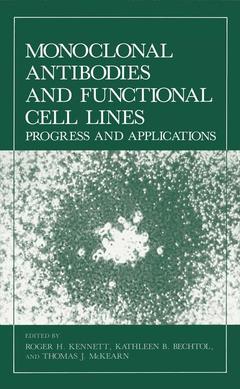This volume serves as a follow-up to our previous book, MonoclonalAntibodies Hybridomas: A New Dimension in Biological Analyses. We continue the theme of monoclonal antibodies and their applications, attempting to cover some of the areas not covered in the previous volume. We again include an appendix de scribing methods useful to those who ar-e beginning to apply these techniques in their own laboratories. This volume will be followed by another concentrating on the combination of monoclonal antibody techniques with molecular genetic techniques to study structure/function relationships at the level of both the gene and gene product. Roger H. Kennett Kathleen B. Bechtol Philadelphia, Pennsylvania Thomas J. McKearn Princeton, New Jersey IX Acknowledgments Roger Kennett acknowledges the patience and support of his wife, Carol, and his family, friends, and colleagues during the work on this volume, and again thanks, above all, the Lord, Jesus Christ. Kathleen Bechtol wishes to thank colleagues and friends for their support and understanding during the months of preparation of this volume. Tom McKearn acknowledges and thanks his wife, Pat, and his family for their support and encouragement. Xl Contents PART I INTRODUCTION 1 Introduction: Reflections on Nine Years of Monoclonal Antibodies from Hybridomas 3 ROGER H. KENNETT, KATHLEEN B. BECHTOL, AND THOMAS J. McKEARN 1. Biotechnology'S "Coming of Age". . . . . . . . . . . . . . . . . . . . . . . . . . . . . . . . . . . . . . . . . . . . . . . 3 II. Monoclonal Antibodies-An Overview of Applications. . . . . . . . . . . . . . . . . . . . . . . . . . . . 6 III. Commercialization of Monoclonal Antibody Technology.. . . .. ... . .... .... .. . ... . . 10 References. . . . . . . . . . . . . . . . . . . . . . . . . . . . . . . . . . . . . . . . . . . . . . . 13 . . . . . . . . . . . . . . . . . . . . .




